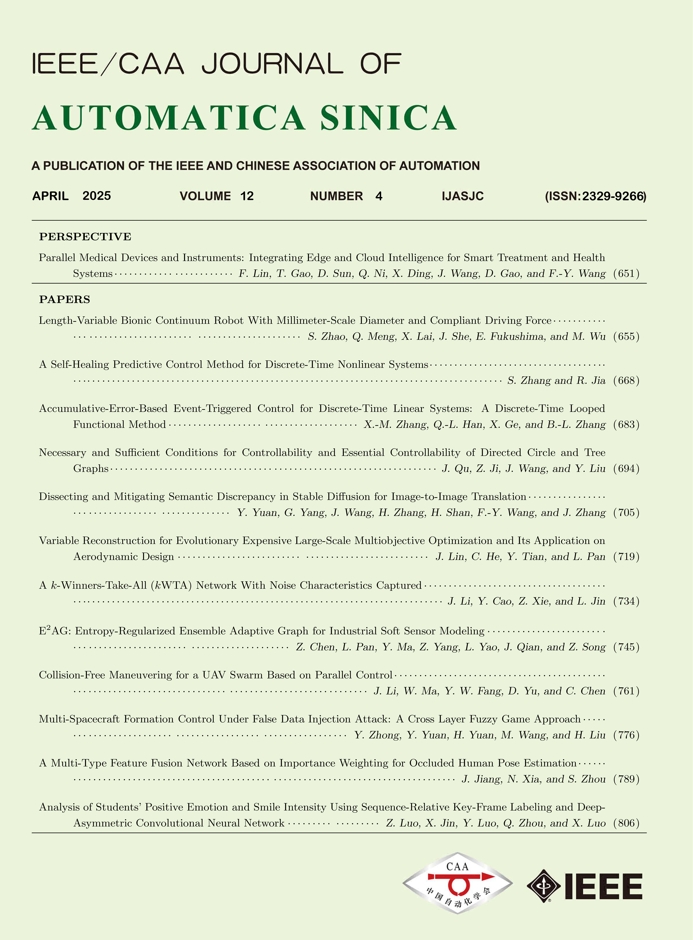Manuscript Requirement
IEEE/CAA Journal of Automatica Sinica operates a double-blind policy for paper review process. Please note that, therefore, any submissions breach this policy, such as, depositing of the submitted work in any publicly accessible repository (arXiv, etc.), indicating author's information when mentioning the author's previous work, et al., will be rejected immediately at any step as soon as they are found.
Manuscripts submitted to the journal should not have been published and will not be submitted or published elsewhere in English or any other languages, without the written consent of the publisher. Submitted manuscripts may be of four basic types: Reviews, Papers, Letters, and Perspectives (by invitation).
The type "Review" includes review, survey, and tutorial. When submitting Review, please include a cover letter with the following information:
1) Description of topic and its importance, including the contribution of this review to the Community and the distinction in this review with respect to the state-of-the-art review (if any);
2) Brief biography of the author(s) who contribute(s) most on this review to highlight the qualifications for writing reviews. Previously published representative reviews and articles of the author(s) can be attached as references;
3) Background records that extend beyond author’s own work to demonstrate the appeal of the topic to a broad audience.
4) Generally, the Review should be no more than 15 pages with References no more than 130 items.
The contributed manuscripts should reflect the latest developments of the research area, with emphasis on academic novelty and thoughtfulness, as well as practicability. The contributions should highlight the main points, with the dull narration and ordinary derivation reduced or deleted as much as possible. The same statements should not be repeated in Abstract, Introduction and Conclusions.
ORCID (Open Researcher and Contributor ID) is required for all authors as per the IEEE policy. ORCIDs enable accurate attribution and improved discoverability of an author's published work. The author will need a registered ORCID in order to submit a manuscript
Follow these steps to link a ScholarOne account to a registered ORCID:
1) Login to ScholarOne and click on your name in the top right corner of the screen.
2) Click E-mail / Name in the dropdown menu.
3) In the ORCID section at the top of the page, click the appropriate link to either register for a new ORCID or associate the account with an existing ORCID.
4) A new page will open to create and/or validate your ORCID. Once the validation is complete, the new page will close and you will return to ScholarOne.
5) Save the changes to your ScholarOne user account.
Authors who do not have an ORCID in their ScholarOne user account will be prompted to provide one during submission. For more information, please visit the ORCID help center (https://support.orcid.org/hc/en-us).
For an individual to be listed as a co-author, it is mandatory from 06 January 2023 that the primary e-mail address is an institutional one. This applies not only to the submitting author but to ALL authors of each paper. Papers where this requirement is not satisfied will not be put into the review process. To ensure compliance with this requirement the submitting author should, prior to the submission, contact all co-authors and request that they, if necessary, edit contact details in their ScholarOne accounts. Non-institutional e-mails can only be used as the Primary CC e-mail address from this date onward.
Examples of not allowed emails:
…@gmail.com, …@163.com, …@qq.com, …@yahoo.com, …@hotmail.com
Examples of allowed emails:
…@ieee.org, …@[university-emails], …@[industry-emails]
The authors’ information (including order, names of the authors, and corresponding author’s name) should not be changed once the manuscript is submitted.
The manuscripts should be in 2-column format. The writing style should be simple and straightforward, the data should be reliable, and any undue self-appraisal must be abandoned. Manuscripts of low quality, of poor English writing or with tedious quotations will be rejected without review.
* The use of artificial intelligence (AI)–generated text in an article shall be disclosed in the acknowledgements section of any paper submitted to an IEEE Conference or Periodical. The sections of the paper that use AI-generated text shall have a citation to the AI system used to generate the text.
Process for Submission
All prospective authors must submit their manuscripts electronically. DOC or PDF files can be accepted and PDF files are preferred.
Your file should be submitted according to the following procedure:
1) Please go to: http://mc03.manuscriptcentral.com/ieee-jas (ScholarOne Manuscripts System) and follow the instructions to upload your files. You should register a new account for the first submission.
2) Sign the Transfer of Copyright Agreement and e-mail it to jas@ia.ac.cn
3) The author will receive an e-mail message acknowledging successful reception of the submission and assigning a reference number to the submission.
4) The author can inquire about the review status through email. If the manuscript needs some modification, the author will be informed by email.
Review
The Editorial Board will prescreen all submissions and remove from further consideration those that, in its opinion, do not meet the requirements that include but are not limited to: scope of the journal; quality and clarity of presentation; novelty; significance of contribution.
JAS conducts double-blind review. Please delete information about authors (such as in the submitted files. Each paper is reviewed by at least three referees. The acceptance of a manuscript will be notified by the Editor-in- Chief, and review comments will be provided for those rejected ones.
After a paper is reviewed by external reviewers, one of the following decisions will be communicated to the authors:
(1) Accept as it is
(2) Accept with minor revision
(3) Reject with permission to resubmit (Significant changes are needed)
(4) Reject
Please note that we normally allow only one Decision (3) and up to two Decision (2) for a paper.
IEEE takes the protection of intellectual property seriously. Accordingly, all submissions are filtered by CrossCheck, a powerful plagiarism detection software system. By submitting your work you agree to allow IEEE to screen your work. When plagiarism is detected, penalties can be severe and may include strict banning from publishing in all IEEE titles. Please consult http://www.ieee.org/documents/opsmanual.pdf Section 8.2.4. to read about IEEE plagiarism policies.
Copyright
All authors must sign the Transfer of Copyright Agreement before the paper can be published. This agreement enables the publisher to protect the copyrighted material for the authors, without affecting the authors’ proprietary rights. Authors are responsible for obtaining permission from the copyright holder to reproduce any figures or other material included in the paper for which copyright already exists.
Files
Instructions on preparing files for accepted papers
Contact
Editorial Office, IEEE/CAA JOURNAL OF AUTOMATICA SINICA
95 Zhongguancun East Road, Handian District, Beijing 100190, China
Tel: +86 10 82544746 , 82544459
E-mail: jas@ia.ac.cn
Data Policy
In order to make the data more shareable and improve the influence of the articles,IEEE/CAA Journal of Automatica Sinica encourages authors to submit the related data to ScienceDB(https://www.scidb.cn/)once the articles are accepted. When the process is completed, the authors may send the DOI and CSTR of the data to JAS. For the submission procedure of the related data, please refer to: https://www.scidb.cn/en/publishing_process















 E-mail Alert
E-mail Alert


